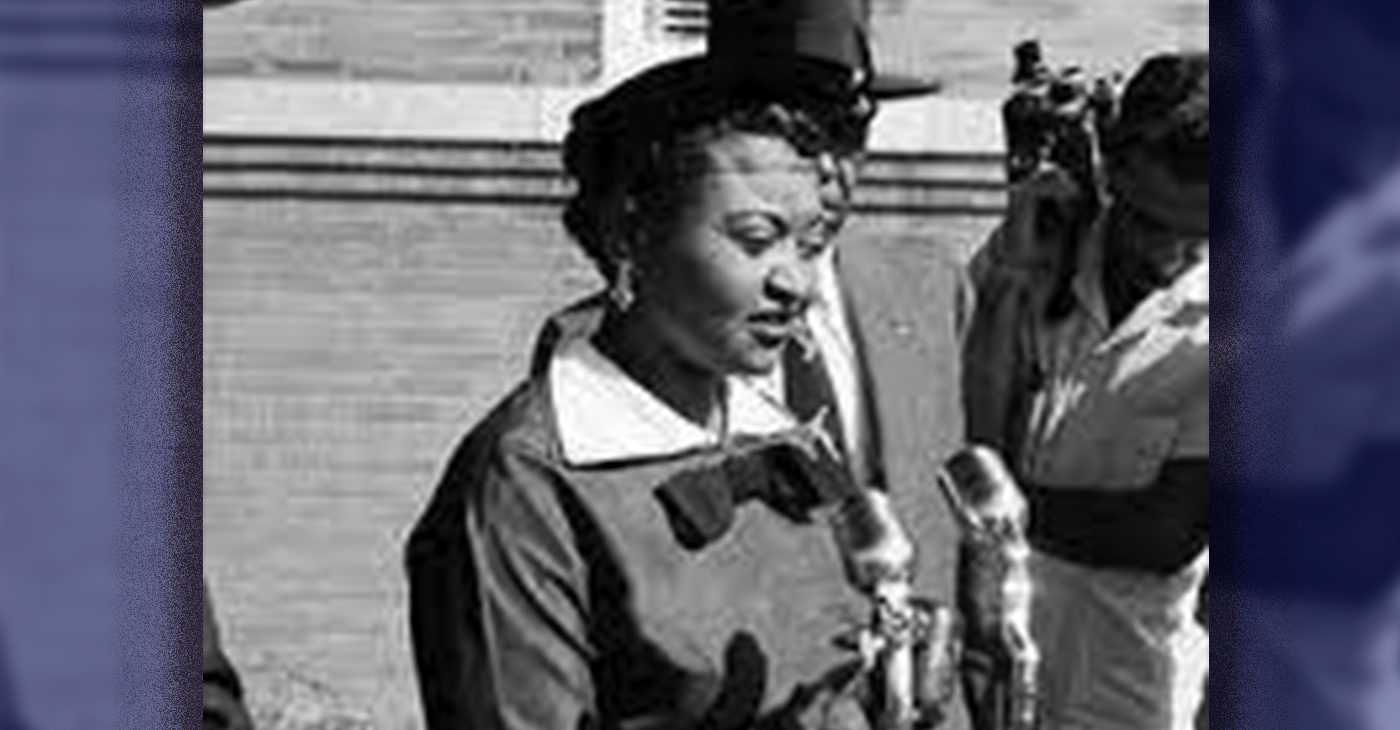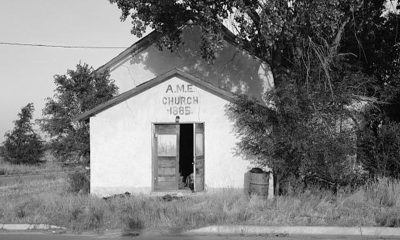Chicago Crusader
COMMENTARY: Christmastime conjures sweet reflections of growing up in Gary
CHICAGO CRUSADER — There is a chasm wider than the Grand Canyon dividing distorted outside perceptions of the “baby boomer” era growing up in Gary, Indiana.
By Vernon A. Williams
There is a chasm wider than the Grand Canyon dividing distorted outside perceptions of the “baby boomer” era growing up in Gary, Indiana. The endearing reality is that sweet memories sustain the test of time for those most familiar with what it was really like being raised in the place once dubbed “City of the Century.”
Long before suburban shopping malls, there were bustling downtowns. Gary sidewalks from 4th Avenue to the tracks just beyond Sears five blocks away, were packed with holiday shoppers in every direction, on both sides of the street. All ages. All races.
Families navigated pedestrian walkways toting shopping bags from Rothschilds, H. Gordon, Penneys, Sears, Comays, Goldblatts, Tom Olesker’s, Fields, Kresge’s, Hurwich and Hallers, Robert Hall, Busch Jewelers, Thom McAn, and Woolworth’s – just to name a few.
Colorful light poles were decorated from the bottom to the top with winding, colorful affectations of the season as Christmas lights were strung across the city’s main thoroughfare, pole to pole. Store Santas pricked the imagination of beaming youth and the music of the season permeated the air – inside and out, of retail establishments.
If families chose, they could drive to a variety of stores and outlets in the Village Shopping Center, Tri-City Plaza, Shopper’s World or any of the myriad stores lining Broadway and the side streets of Glen Park, Midtown, Tolleston or Miller.
The Christmas season was much more than shopping. For children it was sledding, snowball fights, snowmen and making a few extra bucks shoveling after the storms.
The highlight for many was the Holiday Tournament – originally at Memorial Auditorium – drawing eight high schools together for the most intense hoops competition this side of the Final Four. The greatest rivalry was between perennial powerhouse, the Gary Roosevelt Panthers, and the always talented Froebel Blue Devils. Last- second shot endings of some of those games became legend.
In subsequent years Gary Tolleston, Emerson, Lew Wallace and the newest school in town at the time – West Side – had their periods of dominance. As a city, Gary lived up to the reputation of Indiana being the basketball capital of the nation and Gary the hardwood mecca of Indiana.
Winter break was time to skate at Barber’s Playhouse, bowl at Ambassador Lanes, catch a show at Claymans, club on 11th Avenue from the Glass Cage to Mr. Lucky’s with the Blue Room and Zodiac in between; or venture out to Byrd’s Pub, the Park East, Roberts, the Cage, the Millionaire’s Club, Dena’s Pub, Johnston’s or others.
For those dancing to a different drummer, churches throughout the city featured pageantry and special programs for the tiniest parishioner to proclaim in song or poem recognition of the ‘reason for the season.’ And if you didn’t get to church on time Christmas day, you could forget about finding a seat in the pews.
Some Christmases found steel workers’ children filling Memorial Auditorium for an incredible free toy giveaway. And rosy-cheeked carolers in Gary donned colorful suits of 18th Century England with tails and matching top hats as they thrilled businesses, hospitals, restaurants, and schools with their perfect harmony during their rendition of classics.
It’s true that Gary was known as the hub of steel manufacturing in the United States, so even in its heyday the impression from afar may not be warm and fuzzy for those who don’t know better, those whose optics are driven by bad press and unsympathetic imagination, those who prefer the stereotype.
A greater truth is the fact that wonderful families exuded incredible spirits more characteristic of the real Gary than the image of molten steel being poured beneath the puffing smoke stacks of the mills that lined the Lake Michigan shore. Growing up in Gary left an indelible impression on the hearts of residents, past and present.
Gary citizens have always been tough but caring, savvy but sensitive, often limited in material wealth but boundless in resourcefulness, seldom properly acknowledged but unshakeable in confidence of self-worth. There is a reason that so many former Gary residents go to many places around the country and the world and do so well.
Whether a Gary resident’s “hood” was called Delaney, or Ivanhoe, or Tarrytown, or Glen Park, or Aetna, or Froebel district, or Horace Mann, or Emerson district, or Marshalltown, or Miller, or Midtown, or the East Side or West – the common denominator was that we share the common bond of forever being G.I. strong!
Somehow that spirit comes to mind more succinctly during this season. Merry Christmas, Happy Kwanzaa, and Happy Holidays G.I. – Forever Home!
CIRCLE CITY CONNECTION by Vernon A. Williams is a series of essays on myriad topics that include social issues, human interest, entertainment and profiles of difference-makers who are forging change in a constantly evolving society.Williams is a 40-year veteran journalist based in Indianapolis, IN – commonly referred to as The Circle City. Send comments or questions to: vernonawilliams@yahoo.com.
This article originally appeared in the Chicago Crusader.
Activism
How the Black Press Told the World About Emmet Till
Reporter Simeon Booker and photographer David Jackson covered the story for Jet. Other Black news outlets, including the Defender, also later published the photos, though not a single mainstream white outlet did, according to the New York Times. The photos turned Till’s story into “the first great [national] media event of the civil rights movement,” according to historian David Halberstam, who chronicles the murder in his book “The Fifties.”

By Brandon Patterson
The story of Emmet Till has made its way back into the news in recent weeks on the heels of a new TV miniseries and new developments at the federal level.
Earlier this month, the historical docuseries “Mothers of the Movement” premiered on ABC. And last week, the Senate passed a bipartisan bill to posthumously award Emmett Till and his mother, Mamie Till-Mobley, the Congressional Gold Medal.
Emmett Till’s story remains with us to this day, but lesser known is the role of the Black press in bringing his story to light — and in so doing, helping to catalyze the modern Civil Rights Movement.
One of the earliest news outlets to cover the Till story was the Chicago Defender, at the time one of the most influential Black weekly newspapers in the country, with two-thirds of its readership located outside the city, according to the Chicago Tribune.
The account of reporter Mattie Smith Colin, who covered the arrival of Till’s body at a local train station, captured the anguish of his mother as she received her son. Then, Jet Magazine became the first news outlet to publish the gruesome photos of Till’s body at his funeral, which his mother insisted be open casket.
Reporter Simeon Booker and photographer David Jackson covered the story for Jet. Other Black news outlets, including the Defender, also later published the photos, though not a single mainstream white outlet did, according to the New York Times. The photos turned Till’s story into “the first great [national] media event of the civil rights movement,” according to historian David Halberstam, who chronicles the murder in his book “The Fifties.”
Later, Booker’s coverage of the Till murder trial for Jet helped bring the trial to a Black and national audience. Other significant Black newspapers that covered the Till story included the Amsterdam News in New York City, which, by the 1960s, was the largest weekly community newspaper in the nation, the Pittsburgh Courier, and the Atlanta Constitution.
Coverage of Till’s story was notably different in Black news outlets compared to mainstream white papers. In the South, coverage was often sympathetic to Till’s murderers, notes researcher Michael Oby in a 2007 paper on the Till case.
Black papers, however, framed the story as an obvious and horrid injustice. At the same time, they began encouraging their Black readers to get involved in civil rights organizing, and to donate to the NAACP, which was central to the Till case.
Booker, who worked for Jet for nearly five decades, went on to receive an award from the National Press Club for his lifelong coverage of civil rights in America in the 1980s. At the award ceremony, according to the Chicago Tribune, he said of his work: “I wanted to fight segregation on the front lines. I wanted to dedicate my writing skills to the cause. Segregation was beating down my people. I volunteered for every assignment and suggested more. I stayed on the road, covering civil rights day and night. The names, the places and the events became history.”
Because of his work and other Black journalists and news outlets, we know the story of Emmet Till, and so many other critical stories.
This story was written using reporting from the Chicago Tribune, the New York Times, and academic research by Michael Oby at Georgia State University.
#NNPA BlackPress
NATIONAL DAY OF RACIAL HEALING
CHICAGO CRUSADER — January 21, 2020 is the fourth annual National Day of Racial Healing. The day was established in January 2017 by more than 550 leaders from throughout the United States. All across the country people are marking this day in powerful and moving ways, with events and actions of all kinds.
The National Day of Racial Healing is Tuesday, January 21. Truth, Racial Healing, and Transformation Greater Chicago are bringing together people from throughout the city – concerned citizens, business leaders, faith leaders, nonprofit and government leaders, artists, and community organizers – to kick off a citywide effort to confront and heal from racism.
TRHT Greater Chicago will host 3-days of city wide racial healing circles at community centers, government agencies, nonprofits, schools, corporations, and more. Racial healing circles are designed to raise awareness, consciousness and empathy among those who participate.
January 21-23, 2020
Various locations. Visit website for more information.
Sign up to host a circle (organizations)
Sign up to participate in a circle (individuals)
RSVP to attend the NDORH culmination event – Solidarity Heals CommUNITY Celebration featuring guest speakers and musical entertainment, by Chicago’s own Funkadesi.
January 21, 2020 is the fourth annual National Day of Racial Healing. The day was established in January 2017 by more than 550 leaders from throughout the United States. All across the country people are marking this day in powerful and moving ways, with events and actions of all kinds.
So many of the problems plaguing Chicago – violence, troubled schools, health, wealth and opportunity gaps – are rooted in racism that is embedded in our city’s history. The dehumanization of people of color throughout our city’s past and present has caused forced separation, racial inequity, and injustice that impacts our economy, neighborhoods and relationships. This racism is so obvious to some, but not to others.
Racial healing recognizes the need to acknowledge and tell the truth about past wrongs created by individual as well as systemic racism and address the present consequences. We believe it is essential to pursue racial healing prior to making change work in a community. Because, before we can transform systems and structures, we must do the work on ourselves/our people FIRST.
This article originally appeared in The Chicago Crusader.
#NNPA BlackPress
IN MEMORIAM: Garth C. Reeves, Sr., Retired Miami Times Publisher, Dies
CHICAGO CRUSADER — Regarded as a titan in the Black Press, Reeves was widely respected in Miami for using his power and influence to advance the agenda of the city’s Black community. After experiencing the pain and humiliation of segregation in parks, schools and the U.S. military, Reeves grew into an uncompromising crusader who smashed racial barriers in some of the most prominent organizations in Miami and the nation.
By Erick Johnson, Chicago Crusader

Garth C. Reeves, Sr., The Miami Times’ retired publisher who became the enduring patriarch of a family newspaper dynasty after decades of fighting the political establishment and while guiding the Black community through the city’s racial problems, died on Monday, November 25. He was 100.
Regarded as a titan in the Black Press, Reeves was widely respected in Miami for using his power and influence to advance the agenda of the city’s Black community. After experiencing the pain and humiliation of segregation in parks, schools and the U.S. military, Reeves grew into an uncompromising crusader who smashed racial barriers in some of the most prominent organizations in Miami and the nation.
During his lifetime, Reeves’ newspaper got a police chief fired, ended the career of a a Miami Mayoral, supported a boycott that cost Miami Beach’s tourism industry millions, and unapologetically called riots “protests” or rebellions. He stared down Miami’s political establishment that for decades had been accused of shutting out Blacks in government as Hispanics rose to power in the city’s political and business establishments.

He urged his journalists to write from a Black perspective, one that saw the struggle through a different lens than white newspapers.
His newspaper career spanned at least eight decades. At the height of Reeves’ leadership, The Miami Times earned the name, “The Voice of Miami’s Black Community.” One of the last great Black publishers, Reeves’ death closes a significant chapter in The Miami Times’ illustrious history.
Reeves was born February 12, 1919 in Nassau, Bahamas. That same year, Reeves’ father, Harry Ethelbert Sigismund Reeves, moved to Miami where he founded the Magic Printing Company in Overtown, the city’s historic Black, once-thriving neighborhood near downtown. Harry Ethelbert Sigismund Reeves in 1920 founded the Miami Sun, which closed because of a paper shortage during World War I. In 1923, The Miami Times was founded. Reeves was just four years old.
Garth C. Reeves, Sr. was among many Blacks who attended Miami’s esteemed Booker T. Washington Senior High School, the city’s oldest predominately Black high school that was built when students of color were not accepted at white public schools. Black students at Booker T. were given secondhand text books and football gear that came from white schools.

In 1923, Harry Reeves started The Miami Times at NW 8th Street and 3rd Avenue. It would move four more times in the Overtown neighborhood. When Interstate-95 was built through Overtown, it displaced thousands of Blacks. Many fled north to the Liberty City community, where The Miami Times sits at its present location, 900 NW 54 Street.
In 1940, Reeves graduated from Florida A&M University, a major, historically Black school in Tallahassee, FL. In 1942, Reeves was drafted to serve in the Army during World War II. During an interview in 1999, Reeves recalled a trip on a train to the Pacific coast to go overseas. Despite repeated requests, a white train conductor refused to give Reeves something to eat in spite of him having meal coupons. Reeves went to the military police, who told him to do what the white conductor said, or face being locked up on the train. Reeves was forced to pay for his meal because he could not go into the segregated dining car.
Experiences like those would fuel Reeves’ passion for Black journalism’s role in exposing racial injustices while advocating for the needs of disenfranchised people of color.
After completing his service in 1946, Reeves returned to The Miami Times. By then, Blacks could not sit at segregated diners downtown. Members of the Klu Klux Klan would often parade through Miami’s bustling downtown. Parks and schools did not accept Blacks either and living conditions among Blacks worsened as slums in Overtown increased.
Reeves joined Reverend Theodore Gibson, the president of the local NAACP Chapter and began leading protests for better conditions for Blacks in Miami. Out of 28 beaches, only Virginia Key Beach was open to Blacks. On November 7, 1957, Reeves led a group of seven Black leaders to Crandon Park, a segregated white beach near Miami. Reeves and the men earlier talked to several county commissioners, saying that as taxpayers they had the right to frequent Crandon Park or any segregated beach. Wearing their bathing suits under their clothes, Reeves and the men took off their slacks and went into the water while several police officers watched. Blacks began frequenting other white beaches after the incident.
Blacks were not allowed to play at city-owned golf-courses in the 1940s. But that changed when Reeves and Gibson filed a lawsuit that went all the way to the U.S. Supreme Court. In a landmark case, Rice v. City of Miami, the Supreme Court ruled that the city could not continue accepting tax money to build and maintain golf courses while denying its use to all residents.
In an interview on the History Miami Museum website, Reeves recalled an experience he had when Dr. Martin Luther King came to Miami during the Civil Rights Movement.
“When Martin Luther King came down, I attended some of his meetings. My friend was a good friend of King’s and I used to attend meetings where he would preach to us about nonviolence. I remember talking to Martin a few times and I said, “Martin, you really believe that if I was somewhere and a white guy spat on my face, you think I would walk away from that? I said I’d try and kill that son of a b—-. He said, ‘That’s why you’ve got to try to learn to control yourself.’ I liked him.”
That was Reeves the activist.

Reeves, as the publisher of The Miami Times, was just as fierce. It was the only job Reeves would have throughout his life. He worked his way up the ranks as columnist, reporter, managing editor, and editor. When Reeves’ father died in 1970, Reeves became publisher.
By then The Miami Times had established itself as the Black newspaper of record.
During the 1960s The Miami Times ran a front-page story advocating for the termination of Miami Police Chief Walter Headly, whose Stop and Frisk policy of searching Blacks lit up racial tensions in the city. Headly was eventually fired and the Times readership grew.
When four Miami police officers were acquitted in May, 1980 of killing Arthur McDuffie, a Black salesman, Blacks took to the streets. White newspapers and local television stations described it as a riot. With Reeves at the helm, The Miami Times called the incident a “protest.” When another Miami police officer was acquitted in 1993 for killing two Black motorists in Overtown, The Miami Times called the civil unrest a rebellion.
There were other highlights under Reeves’ leadership at The Miami Times.
In 1985, Mayor Maurice Ferre lost the Black vote and was defeated in his re-election bid after The Miami Times ran a series of editorials criticizing the mayor for firing Howard Gary, Miami’s first Black city manager.
In 1993, Reeves and The Miami Times published editorials and stories supporting a boycott of Miami Beach hotels that cost the tourism industry millions of dollars.
Black leaders accused county leaders of snubbing Nelson Mandela after they withdrew plans to give him a proclamation and key to the city when the anti-apartheid leader publicly expressed his support for Cuban Dictator Fidel Castro.
The National Bar Association and ACLU were among many organizations that did not bring their conventions to Miami Beach in support of the boycott.
The boycott lasted three years and cost the tourism industry between $20 to $50 million. Mandela was given an official proclamation and the hotel industry implemented programs to boost Blacks in its facilities. Miami Beach got its first Black-owned luxury hotel, the Royal Palm Crowne Plaza.
“It was important that we had a communication outlet to get our message out,” said H.T. Smith, a prominent Miami attorney who spearheaded the boycott. “The mainstream media would not give us any coverage. The Miami Times was essential to the boycott’s success. The boycott would not have been successful without The Miami Times. And our friendship grew as a result of this partnership.”
Former Miami Times executive editor Mohamad Hamaludin, who worked for 15 years at the newspaper, said, “Reeves was a fine gentleman. By the time I got to The Miami Times, he and the staff had already established it as a voice for people who didn’t have a voice.”
Reeves was the first Black to serve on the boards of the Miami-Dade College, Barry University, the Greater Miami Chamber of Commerce, and the United Way of Dade County. He also served as organizing chairman of the board for National Industrial Bank, which was the first integrated bank in the State of Florida.
While serving on many of these boards, Reeves pushed them to hire more Blacks when they were reluctant to do so. As a board member of Miami-Dade College, Reeves threatened to lead a vote to stop doing business with the school’s law firm because it resisted his calls to hire Black attorneys in its offices.
Reeves assisted Crusader Publisher Dorothy R. Leavell in bringing the NNPA Annual Convention to Gary in 1983 after Black political power gained a foothold in the Steel City.
“He believed in the Black Press very deeply,” said Leavell who first met Reeves in 1962. “Whatever he did, he was always on the right side of the battle. He remained a forward thinker to the very end. He was truly one of the last of the great Black publishers from the old school in the Black Press.”
Today, The Miami Times is the oldest and largest Black newspaper in the Southeast. For the past two years it has been named Best Black Newspaper by the National Newspaper Publishers Association (NNPA), which represents over 200 Black newspapers across the country. In 2011, NNPA named Reeves Publisher of the Year. In 2017, Reeves was inducted into the National Association of Black Journalists Hall of Fame.
In 2017, Miami recognized Reeves with an honorary street sign at 6 Street and NW 2 Avenue near the Black Archives History and Research Foundation of South Florida where he was a board member.
Reeves was a life member of the National Association for the Advancement of Colored People, Sigma Pi Phi Fraternity, Inc., Omega Psi Phi Fraternity, Inc., and a founding member of the Episcopal Church of the Incarnation in Miami, Florida.
He was awarded honorary doctorate degrees from the University of Miami, Barry University and Florida Memorial University.
For years, Reeves had provided scholarships to aspiring journalism students at his high school alma mater, Booker T. Washington.
Reeves served for 10 years as president of the Amalgamated Publishers Inc. in New York City, which represented over one hundred African American-owned newspapers throughout the United States. He was also elected to serve two terms as president of the National Newspaper Publishers Association.
He retired in 1994 and assumed the role of publisher emeritus but Reeves remained active as a prominent leader in the Black community.
Reeves outlived both of his children. In 1982, Reeves’ son, Garth C. Reeves, Jr., died of colon cancer when just 30 years old. This past September, Reeves’ daughter, Rachel died at 68. His grandson, Garth Basil Reeves now heads the family newspaper dynasty at just 29.
This article originally appeared in The Chicago Crusader.
-

 Activism4 weeks ago
Activism4 weeks agoOakland Post: Week of March 27 – April 2, 2024
-

 #NNPA BlackPress4 weeks ago
#NNPA BlackPress4 weeks agoFrom Raids to Revelations: The Dark Turn in Sean ‘Diddy’ Combs’ Saga
-

 #NNPA BlackPress4 weeks ago
#NNPA BlackPress4 weeks agoCOMMENTARY: D.C. Crime Bill Fails to Address Root Causes of Violence and Incarceration
-

 #NNPA BlackPress4 weeks ago
#NNPA BlackPress4 weeks agoCOMMENTARY: Lady Day and The Lights!
-

 #NNPA BlackPress4 weeks ago
#NNPA BlackPress4 weeks agoMayor, City Council President React to May 31 Closing of Birmingham-Southern College
-

 #NNPA BlackPress4 weeks ago
#NNPA BlackPress4 weeks agoBaltimore Key Bridge Catastrophe: A City’s Heartbreak and a Nation’s Alarm
-

 #NNPA BlackPress4 weeks ago
#NNPA BlackPress4 weeks agoBaltimore’s Key Bridge Struck by Ship, Collapses into Water
-

 #NNPA BlackPress4 weeks ago
#NNPA BlackPress4 weeks agoBeloved Actor and Activist Louis Cameron Gossett Jr. Dies at 87





















































